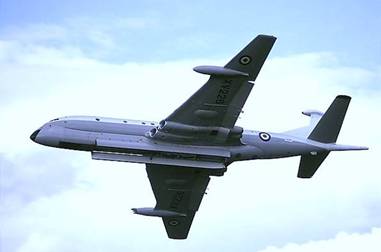 The Nimrod was arguably the best antisubmarine and Maritime Reconnaissance aircraft of the Cold War era. It was designed as a Royal Air Force maritime patrol aircraft, its major role being antisubmarine warfare (ASW), although it also had secondary roles in maritime surveillance, air-sea rescue and anti-surface warfare. It served from the early 1970s until March 2010 with 6 squadrons; 42 and 236 at RAF St. Mawgan; 120, 201, and 206 at RAF Kinloss; and 203 at RAF Luqa, Malta
The Nimrod was arguably the best antisubmarine and Maritime Reconnaissance aircraft of the Cold War era. It was designed as a Royal Air Force maritime patrol aircraft, its major role being antisubmarine warfare (ASW), although it also had secondary roles in maritime surveillance, air-sea rescue and anti-surface warfare. It served from the early 1970s until March 2010 with 6 squadrons; 42 and 236 at RAF St. Mawgan; 120, 201, and 206 at RAF Kinloss; and 203 at RAF Luqa, Malta
The development of the Nimrod patrol aircraft began in 1964 as a project to replace the Avro Shackleton. The Nimrod design was based on that of the Comet 4 civil airliner which had reached the end of its commercial life. The Nimrods were not modified Comets; rather they took the design of the Comet, modified it extensively, and then built new aircraft, which became the Nimrods. The Comet's turbojet engines were replaced by Rolls-Royce Spey turbofans for better fuel efficiency, particularly at the low altitudes required for maritime patrol. Major fuselage changes were made, including an internal weapons bay, an extended nose for radar, a new tail with electronic warfare (ESM) sensors mounted in a bulky fairing, and a MAD (Magnetic anomaly detector) boom. After the first flight in May 1967, the RAF ordered 46 Nimrod MR1s. The first example (XV230) entered service in October 1969
The Nimrod was the first jet-powered Maritime Patrol Aircraft (MPA). Jet engines are most economical at high altitudes and less economical at low altitudes; the aircraft travelled to the operational area at high altitude, which was economical on fuel and fast compared to earlier piston aircraft. On reaching the patrol area the Nimrod descended to its working altitude, often as low as 200 feet (or 100 feet in wartime). Once on patrol at high weight all four engines are used, but as fuel is consumed and weight is reduced first one and then a second engine is shut down, allowing the remaining engines to be run at an efficient RPM rather than running all engines at less efficient RPM. All engines were used for travel back to base at high altitude.
The Nimrod gave sterling service during the "Cod Wars" between Iceland and the UK over fishing rights in the 1970’s. During the Falklands war (Operation Corporate), several Nimrods combed the sea for enemy submarines. The Nimrods took part in Operation Granby (the Gulf War 1990 / 1991), the NATO operations against Serbia in 1999, Operation Telic (the Iraq war in 2003 and beyond), the campaign in Afghanistan, and over Libya in 2011. They also were a routine component of British Search and Rescue (SAR) operations in the North Sea. The Nimrod had an impressive range for a Maritime Patrol aircraft of nearly 6,000 miles, and also had the longest bomb bay of any military aircraft flying. Under the wing it could carry air-to-air missiles (Sidewinder AIM-9, during the Falklands War) and air-to-surface missiles (Nord AS12, Martel, Maverick or Harpoon). In the bomb bay it could carry air dropped torpedoes, depth charges, nuclear depth bombs, naval mines, sonobuoys, and survival equipment.
This was Pete Finlay’s first operational aircraft during his RAF service and he flew the aircraft on 120 Squadron at RAF Kinloss from 1975 to 1979. He took part in the Cod Wars around Iceland in 1975 and 1976 as well as antisubmarine and reconnaissance operations, mainly over the North Sea. He also took part in many Search and Rescue operations, including the Fasnet Yacht Race disaster in August 1979.

